|
|
|
Sort Order |
|
|
|
Items / Page
|
|
|
|
|
|
|
| Srl | Item |
| 1 |
ID:
168324
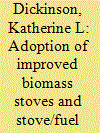

|
|
|
|
|
| Summary/Abstract |
In order to support transitions away from open-fire cooking and toward cleaner household energy systems, a better understanding of users’ technology adoption patterns and preferences is needed. This paper highlights key factors influencing use of two types of biomass-burning stoves provided through the REACCTING (Research on Emissions, Air quality, Climate, and Cooking Technology in Northern Ghana) randomized intervention study. We examine traditional and improved stove use over a two year follow up period, finding that the more basic rocket stove was used at a higher rate than the higher-tech gasifier stove. While stove use patterns varied by stove group, region, primary cook occupation, and socioeconomic status, use of traditional stoves remained high across most groups. Users perceived that improved stoves were less suitable for cooking a staple dish, Tuo Zaafi (TZ), and technical problems (e.g., battery failures with the gasifier stove) also limited the effectiveness of the intervention. Moving forward, household energy policies should prioritize a range of technologies that have potential to meet local needs while delivering meaningful health and/or environmental benefits, recognizing that stove and fuel “stacking” is likely to persist. A greater focus on markets and enabling environments is needed to support sustainable and scalable energy transitions.
|
|
|
|
|
|
|
|
|
|
|
|
|
|
|
|
| 2 |
ID:
168307
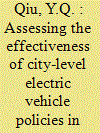

|
|
|
|
|
| Summary/Abstract |
Diffusion of electric vehicles (EVs) is regarded as an important strategy for promoting renewable energy development and controlling CO2 emissions in China. Thus, several incentive measures and policies have been released by the pilot cities in China. The question arises as to whether these policies are effective in promoting the EV deployment. This paper assesses the effectiveness of various EV incentive policies at city level by using the data from 88 Chinese pilot cities. Our regression results show a positive relationship between EV sales volume and two demand-side policies: charging discount and infrastructure construction subsidy. However, purchase subsidy policy is found to have no significant effect. Parking benefits policy shows no effect on promoting EV sales. On the other hand, two supply side policies — model development award and manufacturing award — are not effective. We suggest that local governments may keep those two effective policies, phase out the purchase subsidy policy, terminate the parking benefits policy and suspend the model development award policy. The manufacturing award policy can either be paused or be bundled with other regulations or policies that make specific requirements for EV quality.
|
|
|
|
|
|
|
|
|
|
|
|
|
|
|
|
| 3 |
ID:
168337
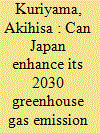

|
|
|
|
|
| Summary/Abstract |
This study investigates the stringency of Japan's greenhouse gas emissions reduction target for 2030 (nationally determined contribution: NDC), focusing on the macroeconomic assumptions of Kaya indicators and others previously overlooked, e.g. GDP per working-age population. It also conducts a decomposition analysis in light of historic political and economic events.
We find that the real GDP growth assumption underlying the NDC target is unrealistic. Namely, the real GDP per working-age population, which is an indicator of productivity, needs to be improved annually by 2.5% on average for 15 years, a high level that has not been observed since the collapse of the economic bubble in the early 1990s.
|
|
|
|
|
|
|
|
|
|
|
|
|
|
|
|
| 4 |
ID:
168320
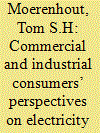

|
|
|
|
|
| Summary/Abstract |
This paper investigates the perspectives of commercial and industrial consumers on electricity pricing reform in Uttar Pradesh, India. In a first study of its kind, we report results from semi-structured, in-depth interviews that were conducted with a variety of firms, based on their electricity price dependence and employment. Results show that senior management officials already strongly oppose cross-subsidy policies in which they pay higher tariffs to reduce prices for households and farmers. Firms also have very few available coping mechanisms to deal with further electricity tariff rises. Senior management officials believe their firms will have to compromise on electricity usage if prices are increased again. Available models suggest that this will likely be a cause for lowering output and overall machine and labor productivity. While firms do expect price rises in the short term, they believe this will impact their productivity and have a low opinion of the state government. This might be aggravated by little knowledge about the price setting mechanism, their means of participation and the level of utility dependence on state subsidies.
|
|
|
|
|
|
|
|
|
|
|
|
|
|
|
|
| 5 |
ID:
168297


|
|
|
|
|
| Summary/Abstract |
Turkey relies heavily on imported fossil fuels to meet a significant portion of its domestic energy demand. This has resulted in a rapid increase in the country's Greenhouse Gas (GHG) emissions over the past decade and raised questions about energy security. To address these challenges, Turkey has established several renewable energy targets, including a target to produce 30 percent of domestic electricity from renewable resources, such as wind, solar and biomass, by 2023. The biomass component is set to reach 1000 MWe by 2023. Given Turkey's large agriculture sector, this paper examines whether agricultural residues can play a role in meeting the biomass component of the renewable electricity target. The analysis is carried out at provincial level, using country-specific data and inputs from national experts and focuses on the crop and livestock bioenergy chains. The assessment results illustrate the bioenergy potential at provincial level, and consequently identify which bioenergy supply chains could be most feasible by province. The paper also quantifies the degree to which the selected bioenergy supply chains can contribute to achieving the biomass component of the renewable electricity target.
|
|
|
|
|
|
|
|
|
|
|
|
|
|
|
|
| 6 |
ID:
168333


|
|
|
|
|
| Summary/Abstract |
Public utilities and regulators are implementing various forms of regulatory mechanisms that decouple revenues from commodity sales to remove a disincentive or create an incentive for utilities to invest in and encourage consumers to conserve electricity, natural gas and water. A major question is whether such regulatory mechanisms affect investor-perceived risk, the cost of common equity and the utility rates of such commodities. This is an important question as regulators in the US are and have been considering the impact of decoupling on investment risk and therefore the cost of common equity in rate proceedings. This matter is also important for regulators globally as they consider decoupling as a policy initiative in setting rates and rate of return. Currently, decoupling is primarily a US ratemaking policy for energy and water utilities as are price caps in Europe. Empirical testing, based on the available data in the US, consistently demonstrates that decoupling has no statistically measurable impact on risk and the cost of common equity. Therefore, at this juncture, policy is moving ahead, at least in the US, without empirical evidence on whether it does have impact on risk and return.
|
|
|
|
|
|
|
|
|
|
|
|
|
|
|
|
| 7 |
ID:
168339
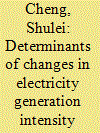

|
|
|
|
|
| Summary/Abstract |
This study analyzes the determinants of changes in electricity generation intensity in China and further uncovers the reasons for the differences between the changes in electricity generation intensity in the thermal and sustainable power sectors. By developing a factorial-intertemporal nested decomposition technique using the refined Laspeyres index, we demonstrate the contributions of electricity generation structure, electricity generation-to-consumption ratio, production electricity consumption intensity, residential electricity consumption intensity, and electricity consumption loss intensity effects. Although the electricity generation intensity of the thermal power sector has been lower than that of the sustainable power sector, the latter has declined remarkably and has remained the key sector driving the overall changes in electricity generation intensity. Meanwhile, the effect of electricity consumption intensity is the main factor that reduces electricity generation intensity. Moreover, the impact of production electricity consumption intensity in the thermal power sector exceeds its impact in the sustainable power sector. Ultimately, we find that the differences between the changes in electricity generation intensity in the thermal and sustainable power sectors are mainly due to their differences in production electricity consumption intensity.
|
|
|
|
|
|
|
|
|
|
|
|
|
|
|
|
| 8 |
ID:
168308


|
|
|
|
|
| Summary/Abstract |
Government policies continue to grapple with the direction of the energy industry as the uptake of variable renewable energy (VRE) continues to impact the viability of traditional energy utility business models. To understand current governmental discourses and approaches to planning for a rapidly changing sector, the discourses of 63 European and Australasian energy strategy documents were identified and analysed using content analysis. Findings identified 6 energy strategy discourses: Energy Scout, Energy Pontificator, Energy Muddler, Political Footballer, Pure Politics, and Neoliberal Energy Economics. The research uncovered that although all discourses are focused on providing energy-security, affordability and reliability to their citizens and industry, only some touch upon the need for new business models to deal with changing energy market landscapes. All discourses were found to rarely consider the future impact of increasing VRE on the business models of energy companies within the energy sector. This paper outlines proposed actions for policymakers of each of the 6 energy discourses to adapt their future energy strategies to better deal with the ongoing uptake of VRE. Ultimately, without viable business models to back it, the best renewable technology and policy will fall short of the transition required to develop a sustainable energy sector.
|
|
|
|
|
|
|
|
|
|
|
|
|
|
|
|
| 9 |
ID:
168338


|
|
|
|
|
| Summary/Abstract |
I live in Burlington (pop. 43,600), state of Vermont (pop. 624,000), USA (pop. 326,000,000). We are the first U.S. city to become 100% renewable in electricity. We get hydro electricity from as far away as 700 km. (in Quebec, Canada) and as close as 1 km. Our wind electricity comes from sources 25–250 km distant. Our 50 MWe biomass plant burns forestry residues harvested within 160 km. Burlington now plans to become a “net-zero energy” city by 1. providing this renewable electricity (more) locally, and 2. extending coverage to present uses of fuel oil, petrol, and natural gas, with the notable exception of airplane fuel. This spatial reach has historically been de-emphasized in waves of enthusiasm for energy efficiency, sustainability (often loosely defined), and now renewability-especially in confronting greenhouse gas (GHG) emissions. I briefly review this history, and then present quantitative spatial impacts of Burlington's plans.
|
|
|
|
|
|
|
|
|
|
|
|
|
|
|
|
| 10 |
ID:
168330


|
|
|
|
|
| Summary/Abstract |
In this study the non-parametric method of Data Envelopment Analysis (DEA) is applied to determine the technical efficiency (TE) index of the G7 countries, when variable returns to scale (VRS) hold for the entire period under consideration (1993–2016). As inputs labor and capital are used while we utilize GDP as output. In the second stage of our analysis the DEA bootstrap approach along the lines of Simar and Wilson (2007) is applied to deal with the disadvantages of a non-parametric DEA set up. Through this procedure we investigate the relationship between the efficiency evaluation of DMUs as calculated by the DEA method, in the first stage of our analysis, and the variables of arable land, total greenhouse gas emissions and total primary energy consumption. In addition, for these variables and through the estimated regression coefficients, elasticities and marginal effects of both TE and GDP index are calculated.
|
|
|
|
|
|
|
|
|
|
|
|
|
|
|
|
| 11 |
ID:
168335


|
|
|
|
|
| Summary/Abstract |
This article investigates the influences of credit policy and financial constraints on tangible and research & development (R&D) investments from China's firm-level renewable energy industry using dynamic panel generalized moments of method (GMM) analysis. China's renewable energy industry has exuberant tangible investments, and its annual R&D investments are increasing. The empirical results demonstrate that firm-specific features, credit policy and financial constraints have significant impacts on the tangible and R&D investments in the renewable energy industry. Greater commercial bank credits, richer liquid assets, higher returns on assets and better investment opportunities may promote renewable energy firms' tangible investments, while more long-run debts and higher bank dependence may reduce their tangible investments. Larger firm sizes, more short-run debts, higher liability leverages, richer liquid assets and greater bank dependence may increase renewable energy firms' R&D investments, while more long-run debt and greater commercial bank credits may decrease their R&D investments according to the results of the study.
|
|
|
|
|
|
|
|
|
|
|
|
|
|
|
|
| 12 |
ID:
168323


|
|
|
|
|
| Summary/Abstract |
Governments and energy operators are frequently confronted with opposition to the construction of new high-voltage transmission lines. In this context, a recent experiment by Mueller et al. (2017) tested the so-called proximity hypothesis and found that spatial proximity to proposed transmission line corridor route alternatives significantly affected residents' likelihood of having negative risk expectations, showing low levels of support, and engaging in protest against the planned facility. Moreover, their findings suggest that the relationship between spatial proximity and the dependent variables is appropriately modeled by a distance decay function, showing that effects attenuate with increasing distance from the infrastructure site. Unfortunately, because of the fact that the study is the only one that has tested the proximity hypothesis in the context of planning new transmission lines so far, the existing evidence cannot be considered as a solid knowledge base. Therefore, to strengthen the reliability of the existing evidence, the natural experiment of Mueller et al. (2017) has to be replicated, which is the purpose of the present study. The findings of the replication clearly support the results provided by Mueller and colleagues and provide further empirical evidence that strengthens the proximity hypothesis in the context of power grid expansion.
|
|
|
|
|
|
|
|
|
|
|
|
|
|
|
|
| 13 |
ID:
168319


|
|
|
|
|
| Summary/Abstract |
Within a low-carbon economy networks, governments and enterprises inevitably experience some level of distrust because of the complexity and uncertainty of policies. This study employs a questionnaire survey in China and finds a high level of distrust between government employees and enterprise managers when low carbon policies are enacted. However, the survey results also indicate a low frequency of communication on low carbon policy and that government employees and enterprise managers frame each other negatively. Furthermore, according to the result of a linear structural relations model, the frequency of communication and the ways in which government employees and enterprise managers frame each other are negatively correlated with the level of distrust. Therefore, an open policy process, co-working, and information sharing could all be effective ways to decrease the level of distrust. Moreover, specific low-carbon policies need to be established especially specific low-carbon standards for products, so as to reduce enterprises' distrust in low carbon policies.
|
|
|
|
|
|
|
|
|
|
|
|
|
|
|
|
| 14 |
ID:
168300


|
|
|
|
|
| Summary/Abstract |
The financial cost of personal energy consumption is substantial at the organizational level. Rarely do incentives for saving energy for the individual employee and organization align, making conservation a challenge. Here we perform a 12-week field experiment piloting two behavioral strategies: (1) social norms feedback and (2) awareness of energy monitoring, to encourage savings among 46 administrative staff at a university who were given the impression of participating in an energy quality study to reduce self-selection bias. Those in the social norms feedback condition used significantly less energy during the intervention (10% less energy) and follow up monitoring (11% less energy) phases compared to their baseline consumption. Moreover, these participants demonstrated that they learned more about their energy use than did those in the awareness monitoring condition. For policy makers and building mangers interested in the effectiveness of behavioral nudges in inducing energy savings, social norms feedback appears to be an effective energy savings nudge in an organizational setting where there are neither financial savings at-stake nor intrinsic motivation to conserve.
|
|
|
|
|
|
|
|
|
|
|
|
|
|
|
|
| 15 |
ID:
168302


|
|
|
|
|
| Summary/Abstract |
We analyze domestic household energy demand and use patterns in Tanzania, using a detailed household survey of purchase transactions, a multivariate probit model, and the QUAIDS modeling framework. The main fuel sources that we study are kerosene, charcoal, and firewood. These three accounted for 96.5% of spending on energy by households. Charcoal and firewood are used for cooking while kerosene is used for lighting and cooking. Kerosene is almost exclusively imported, while charcoal and firewood are produced domestically. These fuel sources are important, given the impacts of wood harvesting on the environment and kerosene imports on public finances. We find a statistically significant response in kerosene demand to charcoal prices, suggesting a pattern of substitution, but no strong substitution relationships between other fuel pairs. These results, which we use in a simulation of tariff change, imply that policies centered on price changes may not be effective in changing consumer behavior unless alternative sources of energy are readily accessible.
|
|
|
|
|
|
|
|
|
|
|
|
|
|
|
|
| 16 |
ID:
168336
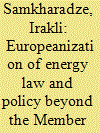

|
|
|
|
|
| Summary/Abstract |
The external dimension of EU energy law is gaining momentum in legal scholarship. The European Union has reached a certain degree of influence in exporting its internal energy rules and values beyond the Member States. Nevertheless, the theory of legal harmonisation between the EU and ‘third countries’ remains underdeveloped. This paper aims to address this deficit by analysing the effects of legal harmonisation in energy outside the current domain of the EU. The paper draws on the example of Georgia, as a Contracting Party to the Energy Community Treaty, and assesses the potential impact of EU energy legislation on Georgia's municipal law triggered by the Community membership. It further uncovers a number of uncertainties that are likely to arise before Georgia in the course of implementing the energy acquis and advocates for the process to be guided through a set of common energy law principles. These aspects are discussed to explain the nature of expanding EU energy law and policy in ‘third countries’ and to contribute to the ongoing debate about energy law, as an emerging academic discipline.
|
|
|
|
|
|
|
|
|
|
|
|
|
|
|
|
| 17 |
ID:
168299


|
|
|
|
|
| Summary/Abstract |
Energy efficiency is widely recognized as a cost-effective strategy to meet energy demand. The U.S. energy service company (ESCO) industry generates significant energy savings and other benefits through installing and maintaining energy efficiency, renewable and other types of projects. In this study, we evaluate factors that may explain trends in the economic performance of U.S. ESCO projects by analyzing project level data for ∼7000 U.S. ESCO industry projects. We find that real project investment levels normalized for floor area have increased over time in ESCO projects across market segments. However, the dollar value of energy savings and other reported benefits have not kept pace with increases in real project investment levels over time. The latter have increased 100%–500% in various market segments from 1990 to 2017. We conduct an econometric analysis to decompose the drivers of these underlying trends. Number of measures and a changing mix of conservation measures are the primary factors that correlate with the long-term increase in project investment levels. However, our analysis is only able to account for less than 50% of the increase in real investment levels. We discuss additional factors, and conclude discussing policy implications and outlining long-term research needs.
|
|
|
|
|
|
|
|
|
|
|
|
|
|
|
|
| 18 |
ID:
168322


|
|
|
|
|
| Summary/Abstract |
Energy poverty is defined as the inability to afford to heat the home to an adequate temperature at reasonable cost. Such a concept has gained political recognition in an increasing number of countries; however, in the United Kingdom, related policies tend to rely upon measures of general deprivation as a practical proxy. This has often resulted in the design of sub-optimal schemes for eradicating this issue.
|
|
|
|
|
|
|
|
|
|
|
|
|
|
|
|
| 19 |
ID:
168303


|
|
|
|
|
| Summary/Abstract |
As electricity consumption in Vietnam has continued to increase much faster than has GDP, electricity intensity (EI) in the country has risen to levels far exceeding those of other Asia-Pacific economies (APEs). By analyzing evidence from a comparative study of other APEs through using the World Bank data, this study proves that EI in Vietnam is excessive and that its escalation over the last few decades cannot be justified as being due to supporting the country's policy of high economic growth. Factor analysis of the economic and electricity indicators for 22 APEs was used to track the shortcomings of the economic structure leading to the EI escalation in Vietnam. Electricity tariff, service share of GDP, and level of institution were identified as determinants of EI across the region. Given the weak performance regarding these indicators, Vietnam has highest EI among APEs followed by China and Mongolia. To reduce EI, Vietnam should consider diversifying away from the electricity-intensive industry sector toward economic activities such as service and information technology. The economic reform should be accelerated to complete the competitive electricity market and reduce the inefficiency of electricity usage through poorly managed state-owned enterprises and inefficient public investment projects.
|
|
|
|
|
|
|
|
|
|
|
|
|
|
|
|
| 20 |
ID:
168312


|
|
|
|
|
| Summary/Abstract |
Carbon emission verification is one of the key factors required for proper implementation of a cap-and-trade (C&T) system. However, to obtain more revenue, emission generating companies (GCs) may collude with third-party verifiers (3 PVs) and conceal real carbon emission data. Based on actual practice of Shenzhen's C&T system, a three-player game model has been devised in this paper to analyze the behaviors among GCs, 3 PVs and government. Given the government's current piecewise linear re-verification policy, the optimal reported carbon intensity for GCs has been provided. Our research reveals that if the actual carbon intensity is larger than historical carbon intensity GCs may report less carbon intensity and conceal actual carbon emission. To deal with this issue, a new exponential re-verification policy is proposed. Based on authentic data from Shenzhen's C&T system, the experimental results show that the government should devote more attention to GCs with a decreasing industrial product output value-added (IVA) than to those with high carbon emissions when selecting GCs for re-verification. Our experiments also illustrate that the new policy outperforms the current one on both total concealed amount of carbon emission and total re-verification cost if the initial re-verification probability is set within a specific range.
|
|
|
|
|
|
|
|
|
|
|
|
|
|
|
|
|
|
|
|
|